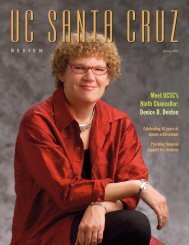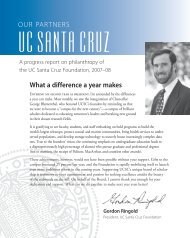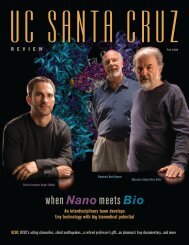Spring - Review Magazine - University of California, Santa Cruz
Spring - Review Magazine - University of California, Santa Cruz
Spring - Review Magazine - University of California, Santa Cruz
Create successful ePaper yourself
Turn your PDF publications into a flip-book with our unique Google optimized e-Paper software.
For new parents, a<br />
child’s first words evoke<br />
joy, pride, and <strong>of</strong>ten more<br />
than a little relief. Those utterances<br />
herald the beginning <strong>of</strong><br />
a new era <strong>of</strong> communication<br />
between infant and adult, as<br />
words take the place <strong>of</strong> crying<br />
and tantrums.<br />
To hasten that developmental<br />
leap, many parents<br />
attempt to “teach” their<br />
children. Eager mothers and<br />
fathers point to everyday<br />
objects, enunciating carefully<br />
and <strong>of</strong>fering up words as<br />
if they were the keys to the<br />
kingdom: “Ball!” “Book!”<br />
“Dog!”<br />
And infants love it. At about<br />
18 months, their vocabularies<br />
take <strong>of</strong>f, and by two years, they<br />
14 UC <strong>Santa</strong> <strong>Cruz</strong> <strong>Review</strong> / <strong>Spring</strong> 2006<br />
The gift <strong>of</strong> gab<br />
Experiments reveal<br />
just how motivated toddlers are<br />
to join the conversation<br />
are “word-learning machines,”<br />
says Nameera Akhtar, a pr<strong>of</strong>essor<br />
<strong>of</strong> psychology at UCSC<br />
and a pioneer in the study <strong>of</strong><br />
language acquisition in young<br />
children.<br />
But the process isn’t as<br />
parent-driven as mommies<br />
and daddies might think. In a<br />
series <strong>of</strong> clever experiments<br />
conducted over the past decade,<br />
By Jennifer McNulty<br />
Akhtar has established that<br />
young toddlers are much more<br />
keyed in to their environment<br />
than researchers ever suspected.<br />
It turns out that they are so<br />
eager to join the conversation<br />
that they approach their “work”<br />
with the focus <strong>of</strong> codebreakers,<br />
picking up signals and learning<br />
all the time, even without<br />
instruction.<br />
Pr<strong>of</strong>essor Nameera Akhtar entices<br />
research subject Natasha Mullins to<br />
play with a distracting pop-up toy.<br />
“We think we’re responsible<br />
for what children learn, but<br />
they are very motivated to<br />
communicate,” says Akhtar.<br />
“Even when we’re not talking<br />
to them, they’re trying to figure<br />
out what’s going on.”<br />
Akhtar conducts her<br />
research in a developmental<br />
psychology lab outfitted<br />
to resemble a family room,<br />
with a couch, a toddler-sized<br />
table and chairs, and colorful<br />
posters on the walls. Only<br />
the 3-by-4-foot mirror that<br />
conceals a one-way window<br />
confirms what insiders know:<br />
It is here that Akhtar’s clever<br />
experiments have revealed the<br />
powerful language-learning<br />
abilities <strong>of</strong> young children.<br />
In one <strong>of</strong> Akhtar’s most<br />
revealing studies, 24-monthold<br />
visitors were welcomed to<br />
the lab, given a fun pop-up<br />
toy to play with, and then<br />
basically ignored by Akhtar<br />
and graduate student Carmen<br />
Martinez-Sussmann. The two<br />
women went through a scripted<br />
exchange about four unfamiliar<br />
objects, one <strong>of</strong> which they referred<br />
to as a “toma”— a madeup<br />
word that was at the heart<br />
<strong>of</strong> the experiment. The children<br />
readily learned the novel word<br />
after merely overhearing it while<br />
engaged with the toy.<br />
“Even at 24 months, children<br />
are keen observers <strong>of</strong><br />
third-party interactions, and<br />
they’re taking in a lot more<br />
Akhtar and grad student Katherine<br />
Herold intentionally ignore Natasha,<br />
whose focus soon moves from the<br />
pop-up toy to Akhtar and Herold.<br />
speech than what is directed to<br />
them,” says Akhtar. The study<br />
also yielded an unexpected<br />
insight into toddler comprehension:<br />
The youngsters looked<br />
up systematically when they<br />
heard a new word and were<br />
clearly responding to new<br />
information. It was the kind<br />
<strong>of</strong> breakthrough that makes<br />
researchers giddy, confirming a<br />
hunch and taking the work to<br />
a new level. “We really haven’t<br />
been giving children enough<br />
credit,” Akhtar says with a shy<br />
smile that belies her determination<br />
to set the record straight.<br />
Akhtar’s work<br />
shows that children<br />
play an active<br />
photos by jim mackenzie<br />
role in their own<br />
development, and<br />
it establishes that<br />
the process begins<br />
much earlier than<br />
researchers thought.<br />
As a graduate student,<br />
Akhtar began<br />
working with 24month-olds.<br />
She<br />
has since studied<br />
18-month-olds and<br />
is now gearing up<br />
to assess 14-montholds—a<br />
prospect<br />
she concedes with<br />
good humor will<br />
be logistically even more challenging.<br />
But, like her subjects,<br />
she is a tireless learner, and she<br />
is already piloting studies to<br />
establish developmental milestones<br />
such as the age at which<br />
children begin to teach others.<br />
She can’t wait to study the differences<br />
in how toddlers learn<br />
from strangers compared to<br />
family members.<br />
In one new study, Akhtar<br />
and graduate student<br />
Katherine Herold will see<br />
if youngsters imitate the<br />
actions <strong>of</strong> people they’re not<br />
directly involved with, like<br />
they pick up new words.<br />
“Some researchers don’t believe<br />
children at 14 months can<br />
learn from an interaction that<br />
doesn’t involve them,” says<br />
Akhtar. “But I want to see if<br />
children at that age can identify<br />
with the other person. Can<br />
they acquire an action through<br />
observation alone, or do they<br />
need to be interacting with<br />
someone to learn from them<br />
at this young age?” Akhtar expects<br />
to see differences among<br />
14-, 18-, and 24-month-olds.<br />
Akhtar’s research is not<br />
only contributing to our<br />
fundamental understanding<br />
<strong>of</strong> child cognitive and social<br />
development, it may indirectly<br />
benefit autistic children, as<br />
well. Half <strong>of</strong> all autistic children<br />
never develop language<br />
skills in part because they lack<br />
the strong desire to connect<br />
with others that motivates<br />
most children to learn to communicate.<br />
Akhtar’s work may<br />
shed light on strategies that<br />
would help these youngsters.<br />
Far from Akhtar’s lab,<br />
in many cultures around the<br />
world, adults do not teach<br />
infants language directly. Yet<br />
the absence <strong>of</strong> focused, oneon-one<br />
parent-child instruction<br />
doesn’t appear to hamper<br />
their development.<br />
“Our understanding <strong>of</strong><br />
language learning is missing<br />
a great deal if we focus only<br />
on speech addressed directly<br />
to the child,” says Akhtar.<br />
Which isn’t to say all those<br />
well-meaning parents should<br />
Graduate student Carmen Martinez-Sussmann (right) observes and videotapes the experimental<br />
session through a one-way window. Natasha’s father, Nick, looks on.<br />
back <strong>of</strong>f. It may not be<br />
necessary in terms <strong>of</strong> a child’s<br />
intellectual development<br />
for mommy or daddy to<br />
label the cat, the boat, and the<br />
shoe, but it’s fun, and that’s<br />
good. “Both babies and parents<br />
enjoy spending that time<br />
together, which is wonderful,”<br />
says Akhtar. “But it may be<br />
more about pleasure than<br />
instruction. Children really<br />
are the engines <strong>of</strong> their own<br />
development.”<br />
UC <strong>Santa</strong> <strong>Cruz</strong> <strong>Review</strong> / <strong>Spring</strong> 2006 15





